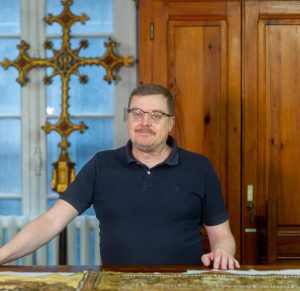The Sanctuary's Heritage Conservation Department
_________________
The mission of the heritage conservation department at the Sanctuary of Our Lady of Lourdes is to preserve and protect works of art and historical objects, to ensure they remain i in good condition for future generations.
This involves implementing preventive conservation measures, such as climate control, appropriate handling of objects, regular monitoring of their condition, documentation and research on the objects. The specific tasks of the department include:
1. Developing and implementing preventive conservation plans for objects in the collection, ensuring that storage and display conditions are appropriate for the objects’ needs by controlling temperature, humidity, light, and air quality.
2. Developing and implementing treatment plans for objects that require intervention for their conservation, such as restoration, consolidation or stabilisation.
3. Recording and cataloguing the collection, following current national standards for the documentation of art and history collections.
4. Documentation of the historical and cultural context of the objects.
5. Regular monitoring of the objects in the collection to detect any signs of deterioration or damage and rapid intervention if necessary.
6. Collaboration with other professionals, such as museum curators, restorers, archivists, art historians and researchers, to ensure a multidisciplinary approach to the conservation and management of the collection.
7. Raising public awareness of the value and importance of the collection through publications, conferences, exhibitions and educational programmes.
Some examples of the heritage being studied and preserved
In order
The Golden Rose of Pius IX
The circular base rests on four pads. The decoration consists of flowering lilies and two statuettes of children, clothed in antique style and representing Hope and Faith, one holding an anchor, the other a cross. Two medallions of champlevé enamel depict the Sacred Heart of Mary, surrounded by a crown of lilies and the bishop’s coat of arms. The edges of the base are highlighted by turquoise enamels mounted in cabochons. On the body, are the arms of Pius IX and the Archbishop of Bourges, Charles-Amable de la Tour d’Auvergne.
Inscription: ‘TO PIUS IX, THE ASSOCIATION OF OUR LADY OF THE SACRED HEART OF ISSOUDUN. 16TH JUNE 1875. MAY THE SACRED HEART OF JESUS BE LOVED EVERYWHERE. THE MISSIONARIES… OF THE SACRED HEART OF JESUS.’
Banner of Saint George slaying the dragon
In the two upper corners of the banner, embroidered with gold thread, flowering rose stems intertwine with oak branches and acorns. The banner has three swags made of gold thread. The two outer fringes are decorated with intertwined oak branches and acorns. The central swag bears the coat of arms of the Kingdom of England – the Norman leopards, the lion and the Celtic harp. The coat of arms is topped with the royal crown of England and a scroll bears the inscription “God and my king”. The main scene, embroidered in its entirety, depicts George slaying the dragon. He is portrayed as a crusader knight, riding a fiery white horse rearing up. The main scene, embroidered in its entirety, depicts George slaying the dragon. He is portrayed as a crusader knight, riding a rearing white horse.
Reliquary of Saint Bernadette
“The Lady of Massabielle” painting
Louis Capdevielle was born in Lourdes into a modest family of slate workers. Noticed for his talent as a painter, he was sent to Paris to study with the best painters of his time: Aimé Millet, Alexandre Cabanel and Léon Bonnat. Struggling to make a living from his art in Paris, he returned to Lourdes in 1890 to eke out a meagre living from his painting. This painting, which stands out from the painter’s other works, was undoubtedly produced during this period of his life. Long overlooked, this artist now seems to be finding his rightful place among the best Pyrenean painters of the 19th century. Capdevielle was a privileged witness to life in Lourdes and the Pyrenees in the second half of the 19th century.
Chasuble from the “Poor Clares of Mazamet”
On the side of the cream silk chasuble, a wide gold-embroidered band decorated with interlacing plants and flanked by four richly embroidered medallions representing: the Immaculate Virgin Mary, Saint Francis of Assisi, Saint Clare, and the Convent of the Poor Clares of Mazamet.
On the back, following the same decorative pattern, a large Latin cross bears, in seven medallions, representations of Jesus Christ Cor (Jesu Sacratissimum), Saint Margaret (Sancta Margarita), Saint Michael (Sanctus Michael), Saint Joan (Beata Joanna), Saint Louis (Sanctus Ludovicus) and Saint Cecilia (Sancta Ceacilia); gold wave-patterned braid; red reverse; protective lace at the collar.
Missal of the Marian Feasts
The Missal of Marian Feasts was donated by the Assumptionist national pilgrimage in 1911. It bears an autograph of Pius X dated 24th September 1911. This precious work was illuminated by the Congregation of the Sisters of Charity and Christian Instruction of Nevers.
Golden crown set on the dome of the Rosary Basilica





